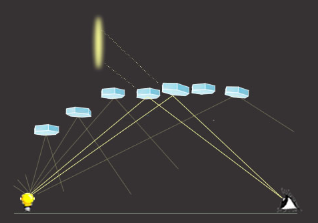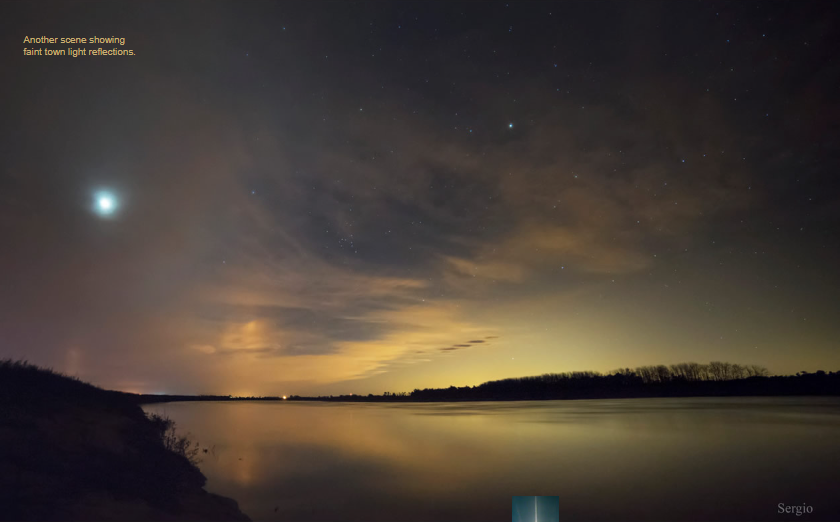Night's Candles, Light Pillars, Argentina - OPOD
Night's Candles: A Captivating Display of Light Pillars in Argentina
On a winter night in July 2015, astrophotographer Sergio Montúfar Codoñer was treated to a mesmerizing sight over the Salado River in General Belgrano, Provincia de Buenos Aires, Argentina. As he set up his camera to capture the night sky, gathering clouds threatened to interrupt his astrophotography session. Little did he know that these clouds would actually contribute to the creation of a rare atmospheric phenomenon known as light pillars.
In the midst of his preparations, Montúfar noticed the first light pillar or sky reflection appearing over the town of Castel, located approximately 50 kilometers away. Soon after, a second light pillar formed over Guerrero. However, it was when he was about to pack away his equipment that an extraordinary scene unfolded before his eyes. The sky was adorned with a stunning display of light pillars, resembling candles illuminating the night.
The enchanting visual effect of light pillars is created by ice crystals suspended in the atmosphere. These tiny crystals act as millions of miniature mirrors, reflecting distant town lights back into the sky. While sun pillars typically form when hexagonal plate crystals in clouds mirror the sun, in this instance, the crystals were mirroring upward-shining ground lights, resulting in fragmented light pillars.
One fascinating aspect of this phenomenon is that unlike sun pillars, which require wobbly crystals to create the effect, light reflections from ground lights do not need such specific crystal orientations. The hexagonal plate crystals responsible for these light pillars drift in the clouds with their large faces almost parallel to the ground, allowing them to mirror the ground lights more easily.
To estimate the height of the ice crystals responsible for the light pillars, we can make reasonable assumptions based on the measurements of the images and knowledge of the camera and lens used by Montúfar. By calculating the crystal height, taking into account the distance between the town lights and the camera, we arrive at a figure of approximately 4.6 kilometers (15,000 feet). This height aligns with expectations for ice-bearing clouds in winter, as the ground temperature during the event was recorded to be between 5 and 10 degrees Celsius.
The captivating images captured by Montúfar showcase the grandeur of this atmospheric optical phenomenon. The top picture, a panorama composed of seven images, was taken using a Sony s7 camera with a 14mm Rokinon f/2.8 lens at ISO 8000. The resulting composition beautifully illustrates the ethereal nature of the light pillars as they dance across the night sky.
In addition to the main scene featuring prominent light pillars, Montúfar also captured another image displaying faint reflections of town lights. This further highlights the versatility and unpredictability of this phenomenon, as it can manifest in varying degrees of intensity and visibility.
Night's Candles, Light Pillars, Argentina - OPOD serves as a captivating reminder of the wonders that can occur in our atmosphere. Through the convergence of atmospheric conditions, ice crystals, and distant town lights, these ephemeral light pillars emerge, captivating the imaginations of those fortunate enough to witness them. So, the next time you find yourself gazing up at the night sky, keep an eye out for these enchanting displays of nature's artistic prowess.

Night's Candles, Argentina
Sergio Montúfar Codoñer (facebook,flickr, 500px) witnessed this highly unusual scene over the Salado River at General Belgrano, Provincia de Buenos Aires.
His astrophotography on the winter night of July 20, ’15 was interrupted by gathering clouds. The first light pillar/sky reflection appeared over the town of Castel 50km distant then a second formed over Guerrero. As he was packing away this amazing scene developed. Scroll right.
All images ©Sergio Mont�far Codo�er, shown with permission

Ice crystals roughly half way between the ground lights and the camera generate the reflections.
Ice crystals acting as millions of small mirrors produced reflections of distant town lights in the sky.
Hexagonal plate crystals drift in clouds with their large faces nearly horizontal. They mirror the sun to form sun pillars but here they mirror upward shining ground lights to produce fragments of light pillars.
Unlike sun pillars, these light reflections do not need wobbly crystals.
If we (reasonably) assume that the crystals were midway between the town lights and Sergio than we can calculate the crystal height from measurements of the image and knowledge of the camera and lens. The height comes out as 4.6km (15,000ft) quite reasonable for ice bearing clouds in winter - The ground temperature was 5-10 Celsius.
The top picture is a panorama from seven images taken with a Sony s7. 14mm Rokinon f/2.8 at ISO 8000

Another scene showing faint town light reflections.
Note: this article has been automatically converted from the old site and may not appear as intended. You can find the original article here.
Reference Atmospheric Optics
If you use any of the definitions, information, or data presented on Atmospheric Optics, please copy the link or reference below to properly credit us as the reference source. Thank you!
-
<a href="https://atoptics.co.uk/blog/nights-candles-light-pillars-argentina-opod/">Night's Candles, Light Pillars, Argentina - OPOD</a>
-
"Night's Candles, Light Pillars, Argentina - OPOD". Atmospheric Optics. Accessed on November 26, 2024. https://atoptics.co.uk/blog/nights-candles-light-pillars-argentina-opod/.
-
"Night's Candles, Light Pillars, Argentina - OPOD". Atmospheric Optics, https://atoptics.co.uk/blog/nights-candles-light-pillars-argentina-opod/. Accessed 26 November, 2024
-
Night's Candles, Light Pillars, Argentina - OPOD. Atmospheric Optics. Retrieved from https://atoptics.co.uk/blog/nights-candles-light-pillars-argentina-opod/.